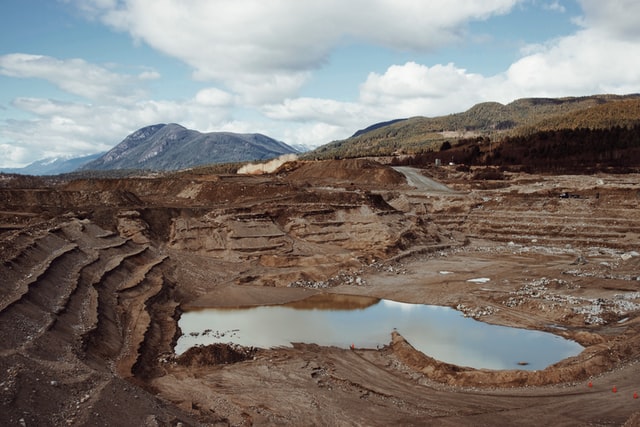The energy transition is an essential part of the fight against global warming. However, it can have very negative consequences at the ecosystems level – particularly on biodiversity. Let’s understand what’s at stake so we can better anticipate and design an ecologically desirable energy transition.
To fight global warming, it is crucial that we quickly leave fossil fuels behind. Specifically, this means that energy sources such as coal, gas or oil must quickly be replaced by something else.
Global power plants will therefore have to be replaced by low-carbon production sources – such as renewables or even nuclear (which is quite controversial).
Internal combustion vehicles will have to be replaced by vehicles using low-carbon energy sources (electric cars powered by low-carbon electricity, “green” hydrogen cars, biogas or biofuel cars). Not to mention that we will have to replace our fossil gas (for heating for example) with renewable gases or other forms of heat production.
Completing this transition is essential to reduce our CO2 emissions, which is why major international climate agreements focus on this crucial task.
But can it be that not all is gold and that this transition to low-carbon energies brings disadvantages too? How does the energy transition lead to increasing pressure on ecosystems and biodiversity? Can these downfalls be avoided?
Energy transition: what materials do alternative sources of energy require?

The energy transition can refer to a multitude of different paths, but as it is envisaged today in the majority of countries of the world, it is often centred around the same major projects.
First, there is the development of renewable energies to replace fossil fuel-based electricity production. There is also the electrification of uses, such as the development of electric vehicles to replace internal combustion vehicles.
Sometimes, these major projects are associated with the development of hydrogen.
By implementing these profound transformations of our energy systems, it would in principle be possible to significantly reduce our CO2 emissions.
However, these transformations are not simple. Moving massively to renewable energies for energy production, for example, means developing a vast infrastructure to produce electricity, transport it, and even store it to compensate for the production gaps of solar and wind energy when there is no sun or wind.
In other words, it is necessary to build thousands or even millions of production sites, produce batteries, storage systems and electricity networks – which means using (and extracting, transporting, etc) plenty of materials.
Copper is used for electricity networks, metals such as lithium are crucial for storage systems, some solar panels need silicon and producing “green” hydrogen requires plenty of electrolyzers. Regarding the latter, these machines that make it possible to transform water into hydrogen thanks to electricity also require resources: platinum or cobalt, or even nickel…
Biodiversity, extractivism and the impacts of the energy transition
If they really want to switch to renewable energy, electric mobility, and use hydrogen on a large scale, industrialized companies will need to extract a lot of different materials, minerals and metals, in large quantities.
In particular, we will have to develop our mining activities in a very significant way, to exploit non-renewable resources. This is called extractivism.
Extractivism could quickly pose significant ecosystem problems. Indeed, in mining areas, there is usually a lot of pollution, natural habitats destroyed, threatened biodiversity. These are all disturbances that profoundly and sustainably affect ecosystems in the broadest sense.
Indeed, several studies have highlighted the links between mines of materials critical to the energy transition and local degradation in ecosystems. For instance, researchers from the University of Arizona State have shown that in the Atacama Desert in Bolivia, lithium mines (a metal essential for electrical use), had seen their surface area increase by nearly 7% per year between 1997 and 2017.
These changes came along with serious impacts on environmental indicators: decrease in vegetation cover, habitat degradation, rising temperatures, drought… not to mention soil and water pollution.
In general, industrial and intensive ministry activities degrade ecosystems and therefore threaten the different species (including us, humans) that inhabit these very same (now different) ecosystems.
Increased mining pressures related to the energy transition

A team of Australian researchers has tried to assess how the energy transition and the associated mining developments might affect global ecosystems.
Their work shows that the planet has nearly 50 million square kilometres of mining areas, more than 80% of which concern materials used to support the energy transition. Unfortunately, this area – which represents about 37% of the planet’s land surface (excluding Antarctica) – covers many crucial areas for biodiversity.
8% of these areas thus coincide with protected areas, while 7% cover areas key to biodiversity and nearly 16% concern areas among the last to be “wild” on the planet. According to the researchers, the energy transition would therefore be likely to “exacerbate threats to biodiversity due to mining activities”.
This raises an essential question: how can we ensure that the development of energy transition projects does not aggravate the degradation of ecosystems and biodiversity?
As of today, measures are put in place to minimize the impact of extraction activities related to the energy transition. According to national regulations, operators are forced to implement on-site conservation and compensation strategies.
But studies that have analysed the effects of these strategies have shown that they have a limited impact on biodiversity protection. Generally speaking, they call for a deeper assessment of the effects of mining activities on biodiversity and for more seriously planning for mining projects that are more respectful of ecosystems at large.
Ultimately, there is a fundamental challenge: building a reference framework today so that the mines that will be required to develop as part of the energy transition in the future minimize their impacts on biodiversity and ecosystems.
It will then be a matter of including these projects in their general environment, thinking about their integration into often fragile areas, which will necessarily put greater constraints on operators in terms of compliance with these standards.
How ecosystems and biodiversity are affected by the energy transition
Low-carbon energy systems have another disadvantage from the point of view of biodiversity and ecosystems: they generally take more space than their conventional equivalents.
To produce the same amount of electricity, wind turbines and solar panels will occupy significantly more space than a coal-fired power plant. Similarly, bioenergy such as biogas or biofuels (which can serve the energy transition under some circumstances) can, in some cases, increase land use or even deforestation, because they require agricultural resources.
This is one of the reasons identified by researchers at the University of Tokyo to explain the greater pressure these energy production sources can generate on biodiversity and ecosystems.
Indeed, the more space is occupied, the more we tend to threaten biodiversity and degrade ecosystems**. Land use is the leading cause of biodiversity loss** worldwide, which has been falling at an unprecedented speed – leading to the collapse of one of the Biosphere’s planetary boundaries.
The need for sobriety for a truly ecological energy transition

For a truly sustainable energy transition that respects ecosystems and biodiversity, many issues are therefore on the table.
On the one hand, it is necessary to develop a more efficient mining system, while probably also developing recycling sectors for batteries or production systems. Optimising the space occupied by these infrastructures must also be carefully taken into account.
However, the most crucial issue is probably to think about the energy transition from a perspective of sobriety. In fact, we must be aware that the ecological transition will only have a positive overall ecological impact if we work to massively reduce our energy needs, which means profoundly transforming our social and economic structures.
Thus, we must not limit ourselves with wanting to replace all our internal combustion cars with electric cars at all costs, which would require increasing battery production and therefore mining.
On the contrary, we must try to find a model to reduce the use of cars in general and to keep the use of the electric vehicle only for situations for which less polluting devices (public transport, bicycle, walking…) do not exist.
Similarly, the transition to renewable energy is not supposed to support an economic and social system that consumes more and more electricity. On the contrary, it makes sense in a system that would seek to minimize energy consumption, thanks to energy efficiency and sobriety.
Adopting such a posture would limit upstream the number of resources needed to develop oversized infrastructure, and therefore the intensity of mining activities necessary for the energy transition.
This is probably the only way to avoid replacing the climate problem with another ecological harm that may turn out to be even more disastrous: the global biodiversity crisis and the destruction of ecosystems.
[Photo by Zbynek Burival, Nikolai Chernichenko and Etienne Girardet on Unsplash]
Note: this is piece is an adaptation from Clement Fournier‘s original article available on Youmatter France.

